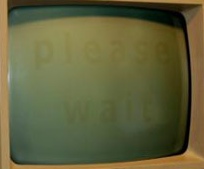Burn-in (screen)
The burn-in (also screen burn-in , a composite from the English word from screen to screen and to burn for burn) describes the process by which a screen displaying static images or overloading an always visible pattern. Depending on the type of screen, this wear and tear is irreversible or temporary.
causes
CRT monitors
In computer monitors the burning is by impinging on the luminescent layer electrons of the cathode ray tube is generated and triggers loaded in only one region, the phosphor layer and weakens the luminance at this point.
Occasionally, however, the problem also occurs due to incorrect deflections on CRT monitors. For example, if the deflection fails, the electron beam is concentrated on a thin line or even a point. In this case it is important to switch off the device as soon as possible to avoid further damage.
Plasma screens
Plasma screens exhibit an effect that is sometimes confused with burn-in. When a group of pixels is very bright for an extended period of time (e.g. because white is displayed), an electrical charge builds up in the pixel structure, which results in a ghost image. In contrast to burn-in, this build-up of charge is temporary and corrects itself if the screen is switched off long enough or if the content changes, e.g. B. displays normal television programs.
However, plasma screens can also show permanent shadow images after long, high-contrast still images. These gradually fade due to the subsequent display of variable images, but this can take a long time depending on the duration and intensity of the triggering still image. According to the manufacturer and experience reports, this effect is particularly intense in the first 100 hours of operation. Therefore, some manufacturers recommend not to increase the contrast above the 50% setting for the first 1000 hours of operation.

Liquid crystal screens
Liquid crystal displays (LC displays) behave similarly, although the details of the process are different. In LCDs, the liquid crystal molecules that "color" the white background lighting as it passes through the membrane lose their rotational elasticity and therefore cannot completely return to their original state. As with plasma screens, this is usually temporary and resolves itself if the screen is turned off for an extended period of time or shows dynamic content.
In severe cases, however, the change can remain permanent.
OLED screens
Screens based on organic light-emitting diodes can show similar phenomena due to the aging of the individual (sub-) pixels at different rates, whereby these lose their luminosity if they are stressed unevenly through permanent display of static image content. Affected areas appear comparatively darker. These changes are permanent and cannot be reversed.
Avoidance
There are several ways to prevent burn-in:
computer
With the computer, after the mouse or keyboard has been idle for a long time, there is the option of no longer sending a video signal to the monitor and thus of having the monitor switched off automatically so that no more electrons hit the luminescent layer. In addition, a screen saver can ensure that the picture changes constantly.
watch TV
Some TV channels do not broadcast an opaque logo, but a semi-transparent logo that allows enough image change. When switching to advertising, it is often animated or permanently animated (e.g. on Sat.1 ), that is, changed in position or color and completely removed from the image during the advertising. Since the distraction in tube television sets is usually not as high as that, the picture drifts a little if there are large changes in brightness in the overall picture (so-called "pumps"). This means that the logo also wanders a bit and does not burn in as clearly.


